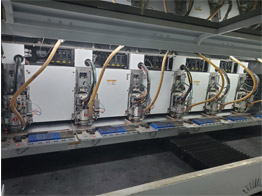What are the key points of PCB backplane design?
2019-12-31

Increasing user demands
for increasingly complex large-size backplanes that can operate at unprecedented
high bandwidths have led to the need for equipment processing capabilities
beyond the Standard PCB manufacturing line. In particular, the
backplane is larger, heavier, and thicker, requiring more layers and
perforations than standard PCBs. In addition, the required line widths and
tolerances are getting finer, and hybrid bus structures and assembly
technologies are required.
Backplane has always been a specialized product in
the PCB manufacturing industry. Its design parameters are very different from
most other circuit boards. It needs to meet some demanding requirements in
production. The noise tolerance and signal integrity also require the backplane
design to follow unique design rules. These characteristics of the backplane
result in huge differences in manufacturing specifications such as equipment
specifications and equipment processing.
As a PCB Assembly Manufacturer, share with you the
requirements of the backplane size and weight on the conveying system.
The
biggest difference between a conventional PCB and a backplane lies in the size
and weight of the board and the processing problems of large and heavy raw
material panels. The standard dimensions of PCB manufacturing equipment are
typically 24x24 inches. Users, especially telecommunications users, require
larger backplanes. This has driven the need for identification and purchase of
large-size plate conveying tools. Designers have to add extra copper layers in
order to solve the routing problem of large pin count connectors, which
increases the number of backplane layers. Harsh EMC and impedance conditions
also require adding layers to the design to ensure adequate shielding, reduce
crosstalk, and improve signal integrity.
When a high-power-consumption
application card is inserted into the backplane, the thickness of the copper
layer must be moderate to provide the required current to ensure that the card
can work properly. All these factors lead to an increase in the average weight
of the backing plate, which requires that the conveyor belt and other conveying
systems must not only be able to safely move large-sized raw material plates,
but also must take into account the fact that they are gaining weight.
The
user's need for a backsheet with thinner cores and more layers brings two
opposite requirements for the conveyor system. Conveyor belts and conveyors must
be able to pick up and transport large gauge sheets less than 0.10mm (0.004
inches) thick without damage, and they must be capable of transporting 10mm
(0.394 inches) thick and 25 kg (56 pounds). Board without dropping board.
The
difference between the thickness of the inner layers (0.1mm, 0.004 inches) and
the thickness of the finished backplane (up to 10mm, 0.39 inches) is two orders
of magnitude, meaning that the conveyor system must be strong enough to safely
transfer them Transfer through the processing area. Because the backplane is
thicker than conventional PCBs, and the number of drilled holes is much, it is
easy to cause processing fluid to flow out. A large 10mm thick backplane with
30,000 drilled holes can easily take out a small amount of processing fluid that
is absorbed in the guide hole by surface tension. In order to minimize the
amount of liquid carried and eliminate the possibility of any drying impurities
remaining at the guide hole, it is extremely important to use high pressure
flushing and air blowers to clean the borehole. Our company also has Aluminum PCB on sale, welcome to consult.
